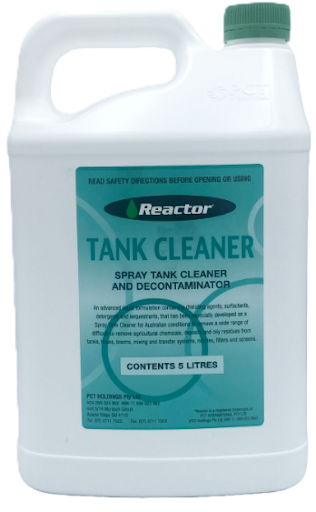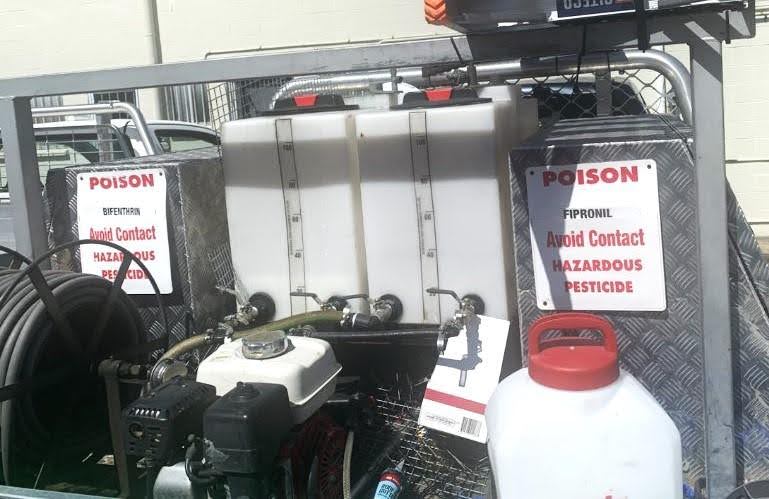Clean tanks make money!
Spray equipment maintenance with PCT’s Reactor Tank Cleaner

Clean hands don’t spread germs – it becomes a symbol of good health and everything that stems from the concept of cleanliness. Like clean bodies, clothes, homes and work environments, the benefits manifest as better performance and profits. A pest controller’s spray tank is no different. PCT’s Reactor Tank Cleaner is designed for the specific purpose of getting rid of all the residues and debris that accumulate in spray tanks.
Spray tanks are accumulators of residues of all the chemicals, such as actives, solvents and adjuvants that are applied through them. Rinsing them out is a necessity, but it is often insufficient to eliminate all residues that stick to various parts, including the sides, hoses, nozzles, and other components. The effects can be hidden until the phone rings from a disgruntled customer for a service call! Which costs money, reducing profits!
The consequences of dirty spray tanks can be serious, affecting insecticide application due to blocked filters, hoses and nozzles. Often, there is a loss of efficacy of the product applied, as residues can interfere both chemically and physically with the applied product. This interaction can also affect the performance and life of the spray tank. Products with high solvent levels such as EC formulations, surfactants and those that lower pH, often lead to solubilization of residues in spray tanks and can have unpredictable consequences on the site of application and the environment in general. Also, many pesticides have optimum pH requirements for stability and can lose efficacy if any residues that affect pH are present in the tank mix.
Presence of small amounts of another residual pesticide along with the intended pesticide can lead to resistance to the residual pesticide (cross-resistance) in the target pests or even other pests, especially if the pesticides have the same mode of action. Similarly, there can be a synergistic effect where both the residual and intended pesticide act together and possibly affect non-target fauna such as natural predators, beneficial insects and even pets. The combined chemicals can also have health effects, such as with the use of acetylcholinesterase-pesticides which affect nerve/muscle in humans.
While a simple solution may be to have dedicated spray tanks, this is often a luxury in monetary terms and quite impractical considering how businesses are managed, with a high turnover of personnel and the wide range of chemicals applied. Also, more sprayers require more cleaning! Therefore, it is best to include spray tank cleaning and hygiene as part of Good Pest Control equipment maintenance.
PCT’s Reactor Tank Cleaner will take care of the ‘gunk’ in spray tanks that is the bane of pest controllers. The clear yellow-green liquid has a mild odour and should be used wearing basic PPE such as gloves and eye protection. Dispose of waste rinse water in accordance with local regulations. Follow up rinsing with plenty of water will ensure that the tank is clean and ready for the next application.
Recommended Use
- Fill the spray tank with sufficient cleaning solution to allow the operation of the spray system for a minimum of 15 minutes to thoroughly flush hoses, spray boom and spray nozzles then fill the spray tank to ensure contact of the solution with all internal surfaces. If possible, let the cleaning solution soak in the tank, pump and spray lines overnight.
- Dispose of waste rinse water in accordance with local regulations.
- Before further use of the sprayer, operate the spray system for 15 minutes, then completely drain the sprayer system. Rinse the tank with clean water and flush through the hoses, spray boom and spray nozzles.
- Repeated use of the sprayer with the same chemical without rinsing out is acceptable, but if there is a change of chemical, thorough cleaning is required. Cleaning is also recommended for subsequent tank use if the sprayer has been left standing with spray solution for a period.
- If storing equipment for more than 48 hours, the preferred practice is to clean spray equipment as outlined above, allowing it to soak overnight, drain and flush with fresh water and leave fresh water in the spray tank, hoses, and spray booms until next use. This water must be drained from the spray boom and lines and flushed out with clean water before beginning any application.

Fazal Sultanbawa
Technical Co-Ordinator